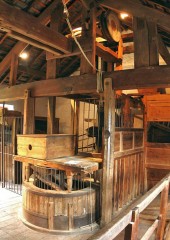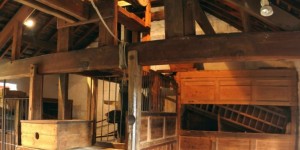The Teffont Archaeological Project has been running since 2008 and aims to further understanding of the archaeology of the village of Teffont Evias in south Wiltshire (see Figure 1), in particular the late Iron Age, Roman and Early post-Roman periods. The previous season's work had identified several areas of Iron Age and Roman occupation through desktop research, geophysics and fieldwalking, and produced a report summarising the current evidence for how the inhabitants of Teffont acted within the landscape during the Roman period, and the changes between the Iron Age and Roman period (Roberts, unpub. 2009). The research team from York and the local community felt that the project should be taken further due to the significant research potential of the area (Draper 2006, 7-8). To this end another season of fieldwork was undertaken in 2009.
The 2009 fieldwork season of the Teffont Archaeological Project had two main research objectives. First, to provide definite locational evidence for Roman domestic settlement in Teffont Evias, and secondly, to begin to place such settlement in its wider landscape context. The fieldwork undertaken consisted of field-walking, geophysics, topographic survey and test excavations. Fieldwork was focused on the 'Glebe' field, which had produced large quantities of Roman pottery, including much samian ware, when field-walked in the previous year (see Figure 2). Geophysical and topographic survey and field-walking were also undertaken elsewhere in the village, and produced evidence for another probable Roman occupation site. An 80x80m area of the Glebe, covering the central area of the field, was surveyed with both magnetometry and resistivity, taking some 25600 readings. Both sets of results showed an area of intense activity corresponding with the concentrations of pottery discovered the previous year, as well as other areas of archaeological remains. Two test trenches were cut across the edges of this activity area, and three test pits cut elsewhere in the grid to ground-truth the geophysics results. One test pit placed deliberately in a blank area of results found no disturbance, as expected. Another placed in a blank area closer to the activity area found no archaeological features, but a number of pot sherds, predominantly Dorset black burnished ware, a local high status ware dating from the mid-Roman period. The third test pit, placed across an area of confused results, produced an arc of stone that may be the top of a boundary feature, together with large body sherds of black burnished ware, nails and animal bone. Deposits indicated multiple layers of use, although time constraints did not allow excavation to natural.
Test trench A produced two main activity zones, separated by a limestone rubble boundary. The first, a large pit, contained an articulated cow skeleton, associated with the closure of the deposit (see Figure 3). The second, in the opposite corner of the trench, contained nails and other metal artefacts. These areas are likely to be areas of domestic activity peripheral to the main occupation, the edge of which was discovered in test trench B.
Due to the intensity of archaeological activity in trench B it was not excavated beyond the first several layers. The upper layers present were very likely the collapse of a substantial wall, which seems to have included opus signinum, and been founded on substantial masonry blocks. A door lintel is clearly visible (see Fig.4), and many finds were excavated, including substantial quantities of pottery (including Samian ware), metal and a possible tesserae tile. That this building was a high status domestic occupation site seems very likely due to quality of finds derived from it, and the quality of construction and materials.
An aim for the following season will be to fully excavate this trench, and attempt to establish the relationships between the exterior activity areas and the occupation site. The proximity of the site to a probable Romano-British shrine in Upper Holt Wood (Grinsell 1957), on the ridge above the field may indicate a religious aspect to the site. These aspects will be fully elucidate, and the context of the site discussed in the full site report for 2009, currently being completed.
Following the 2009 season's discoveries, the team plan to continue working with the local volunteers and community to research Teffont's heritage. One of the most important aspects of the project is its use of multiple methods, and fresh approach to open discussion from all participants regarding methods and interpretation. This allows a training process to take place which has proved immensely rewarding for both project management, students and volunteers. In 2010 fieldwork opportunities are available for 20 University of York students, whether under-graduate or post-graduate, and these will be subsidised substantially by ArcSoc for paid members. To give some idea of the experience available, one of our team members last year, a third year at the time, has provided excerpts from her dig diary.
Teffont Dig Diary, August 2009. Samantha Rowe
Last summer a few of us dedicated York archaeology students spent 3-4 weeks in a big field in the Wiltshire countryside trying to uncover the mysteries of the surrounding Roman landscape. We were based in a quaint little village called Teffont Evias; a place with a long and varied history. Our task was to uncover information about the Roman occupation of the area with very little time and a very small workforce!
Here are a few selected extracts from our Dig Diary 2009, courtesy of me, Sam Rowe; a graduate of York and future excavation supervisor for the 2010 dig.
The first two weeks on-site were spent carrying out geophysical surveys (weather permitting) in a huge field known as 'The Glebe'. A lot of hard work and plenty of hay splinters later and we were able to identify interesting areas to put in some test pits. Sometimes on 'bad weather' days, the team would get the afternoon off (yay!). Other times you ended up being allocated to 'augering', which is a very difficult and tedious way of taking soil samples. Some of us enjoyed augering, but others never did quite get the hang of it, especially when it came to deciding what colour the soil was!
Thursday 27th
We finished the resistivity work! A great sigh of relief from many!
Friday 28th
EXCAVATION BEGAN! We managed to 'hire' a JCB and dug out 5 test trenches. Within 2 hours we had uncovered the remains of stone walling, a batch of pottery, and an articulated cow skeleton! The 3 trenches appropriately became known as 'stone trench', 'bone trench', and 'pot trench'. The next few days were very exciting with more bone and pottery discoveries, with trenches being extended all the time. We were occasionally interrupted by passers-by walking their dogs, asking us what on earth we were doing!
Thursday 3rd Sept
After being delayed by rain, our last day was epic: one day to record as much as we possibly could before the rain washed it away! We must have taken over 400 TST points! We all got a little muddy and hysterical, but our hard work paid off.
People's thoughts on their experience at Teffont:
- Faith (now a 3rd year): "Made archaeology enjoyable...made some really good friends through all the hard work! Learnt more than I ever thought I would."
- Richard (local volunteer): "Sore knees...field turns out to be full of interesting stuff...a new chunk of the big story."
Personally I had a great time. It was very hard work, and by the end of the dig my pathetic tent was about to collapse, but I met some great people and brushed up on my archaeology skills. We all came back to York with a little bit of Teffont in us (mainly in the form of straw splinters!), but were glad we went and can't wait to go back! Like at the end of any dig, this one ended in us thinking, 'if only we had more time!' But there's always the 2010 dig season to look forward to!
Bibliography
- Draper, S (2006) Landscape, Settlement and Society in Roman and Early Medieval Wiltshire. Oxford, BAR British Series 419.
- Grinsell, R V (1957) 'Roman Archaeology' in E Crittal (ed) (1957) Victoria County History of Wiltshire. Volume 1, part 2 - Archaeology , 53-274. Oxford, Oxford University Press for Institute of Historical Research.
- Roberts, D (2009) 'A study of the Roman archaeology of the parish of Teffont, Wiltshire, and its wider context in terms of regional settlement patterns.' Unpublished BA dissertation, York.









